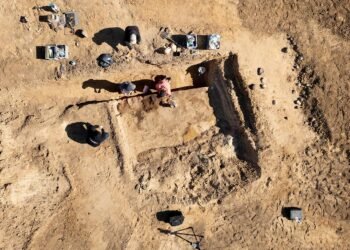Archaeologists from the National Institute of Anthropology and History (INAH) have unveiled a wealth of archaeological treasures at Cima de San José, a pre-Hispanic settlement in the municipality of Tula, southwest Tamaulipas, Mexico.
As part of a salvage archaeology project initiated due to highway construction, the excavation revealed 48 burials linked to the Pueblito and Huasteca cultural complexes, providing the largest osteological sample from this area to date.
The individuals discovered were carefully laid to rest in graves covered by tombstones, adopting varied positions such as seated, dorsal, or lateral flexed, with a distinct preference for orientations aligned with the sunrise and sunset. Notably, the burials were accompanied by an abundance of funerary offerings, including black and red Zaquil vessels, ceramic pipes, seashell earrings, deer bone punches, white flint flakes, obsidian blades, and green stone earrings.
Esteban Ávalos from INAH stated, “What is striking is the number of offerings that were deposited, such as black and red Zaquil-type vessels, ceramic pipes, seashell earrings, deer bone punches, white flint flakes, obsidian blades, and green stone earrings.” The most remarkable among the offerings is a necklace featuring 29 sea snail earrings intricately crafted to resemble the fangs of carnivorous animals.
The archaeological team also conducted an osteological examination, uncovering evidence of dental mutilation in one individual. Dental modifications included worn and sharpened incisors and modified canines with cavities for unknown purposes.
The preservation of some skulls enabled the identification of cranial modifications resembling early North American groups, specifically the tabular erect plano lambdoid cranial modification found in the northern Gulf Coast and Southwest United States.
Cima de San José, situated on a leveled hill 80 meters above the foothills, held paramount importance in the beliefs and socio-political organization of ancient inhabitants.
The site’s cultural significance is evident in historical records, such as Abraham Ortelius’s 1578 map, which refers to it as Tammapul.
According to Esteban Ávalos Beltrán, the project coordinator, the burial sites at Cima de San José have surpassed previous discoveries in number, with a likely temporal correspondence to the Early and Middle Classic periods, spanning from CE 250 to CE 650. The presence of 18 hearths within the burial areas provides essential materials for absolute dating using various techniques, including carbon dating.
The INAH team plans to continue studying the materials to reconstruct various aspects of the culture of Cima de San José, contributing essential data to the understanding of Tamaulipas’ past.
Ávalos concludes that the work carried out with the archaeological salvage team and researchers from INAH Tamaulipas will allow the reconstruction of some aspects of the ancient inhabitants of Cima de San José, as it is one of the last sites that have been excavated with scientific rigor in the southwest of Tamaulipas.
More information: INAH
























